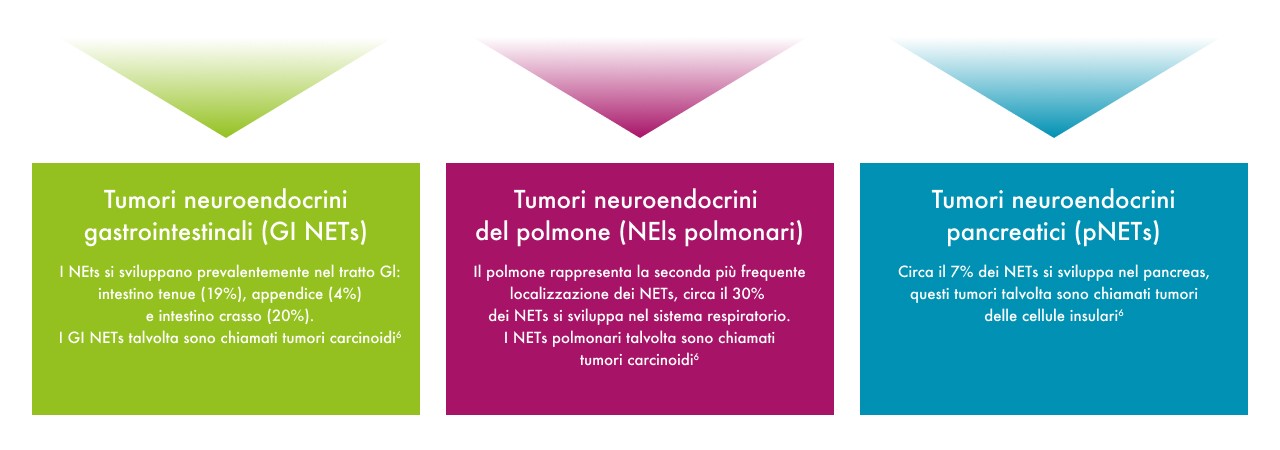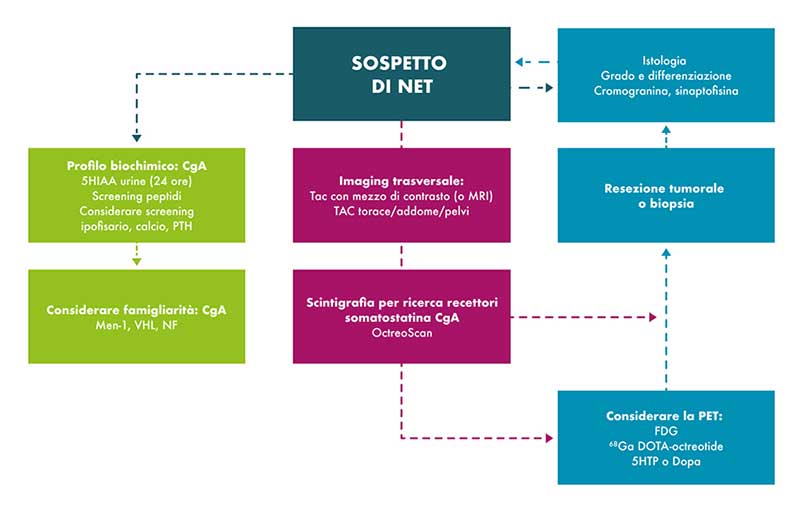Il sistema neuroendocrino, costituito da cellule neuroendocrine, riceve messaggi dal sistema nervoso e risponde mediante la produzione di ormoni.1 Le cellule neuroendocrine sono diffuse in tutto il corpo, si trovano principalmente sparse nel tratto gastrointestinale (intestino tenue, retto, stomaco, colon, esofago e appendice), nei polmoni, nel pancreas e nella tiroide.1 Queste cellule hanno funzioni diverse a seconda di dove si trovano nel corpo, ad esempio, le cellule neuroendocrine nel sistema digerente producono ormoni che aiutano a disintegrare il cibo nello stomaco e a spostarlo attraverso l'intestino.2
I NETs sono rare forme tumorali che hanno origine nelle cellule neuroendocrine.2
I tumori neuroendocrini (NET) possono formarsi in qualsiasi parte del corpo e vengono solitamente classificati in base al sito di origine.


Le cause dei tumori neuroendocrini non sono ancora del tutto chiare.
In alcuni casi la causa è nota e, in rari casi, collegata a una sindrome genetica; si stima che fino al 10% dei GEP-NET abbia un background ereditario:



RIFERIMENTI
1. Canadian Cancer Society. The neuroendocrine system.
2. CRUK. What are NETs.
3. Cancer.net. Neuroendocrine tumours - introduction.
4. NHS England. Neuroendocrine tumours.
5. Singh S et al. 2017. Patient-Reported Burden of a Neuroendocrine Tumor (NET) Diagnosis: Results From the First Global Survey of Patients With NETs J Glob Oncol. 2017;3(1):43-53.
6. Cancer.net. Neuroendocrine tumours - introduction.
7. National Cancer Institute. Cancer terms: GEP-NET.
8. Kizilgul M, Delibasi Gastroenteropancreatic neuroendocrine tumours. T. Transl Gastrointest Cancer 2015;4(1):39-56.
9. Díez M, et al. Gastroenteropancreatic neuroendocrine tumours: diagnosis and treatment. Ann Gastroenterol 2013;26(1):29-36..
10. Kizilgul M, Delibasi Gastroenteropancreatic neuroendocrine tumours. T. Transl Gastrointest Cancer 2015;4(1):39-56
11. Díez M, et al. Gastroenteropancreatic neuroendocrine tumours: diagnosis and treatment. Ann Gastroenterol 2013;26(1):29-36..
12. Klimstra D et al. The pathologic classification of neuroendocrine tumours. Pancreas 2010;39(6):707-712.
13. CRUK. Stages.
14. CRUK . Grades.
15. Cancer.Net. Lung NETs; stages and grades.
16. Cancer.Net. GI tract NETs; stages and grades.
17. Macmillan. Neuroendocrine tumours.
18. O'Shea T, Druce M. When should genetic testing be performed in patients with neuroendocrine tumours. Rev Endocr. Metab. Disord. 2017; 18(4): 499-515.
19. UpToDate. NF1 clinical manifestations.
20. WebMD. NET causes.
21. WebMD. NET causes.
22. Oronsky B, et al. Nothing But NET: A Review of Neuroendocrine Tumors and Carcinomas. Neoplasia. 2017;19(12):991-1002.
23. Sahani DV, et al. Gastroenteropancreatic Neuroendocrine Tumors: Role of Imaging in Diagnosis and Management. Radiology. 2013;266(1).
24. Dasari A et al. Trends in the Incidence, Prevalence, and Survival Outcomes inPatients With Neuroendocrine Tumors in the United States JAMA Oncol. 2017;3(10):1335-1342.
25. Chauhan A et al. Global burden of neuroendocrine tumors and changing incidence in Kentucky. OncoTarget. 2018;9(27).
26. Cancer.Net. Symptoms and signs.
27. Cancer.Net. Symptoms and signs.
28. Image source: Ramage JK, et al. Guidelines for the management of gastroenteropancreatic neuroendocrine (including carcinoid) tumours (NETs) Gut. 2012; 61:6-32.
29. Image source: Ramage JK, et al. Guidelines for the management of gastroenteropancreatic neuroendocrine (including carcinoid) tumours (NETs) Gut. 2012; 61:6-32.
IT/LAN/NP/0005 - 26/05/2025